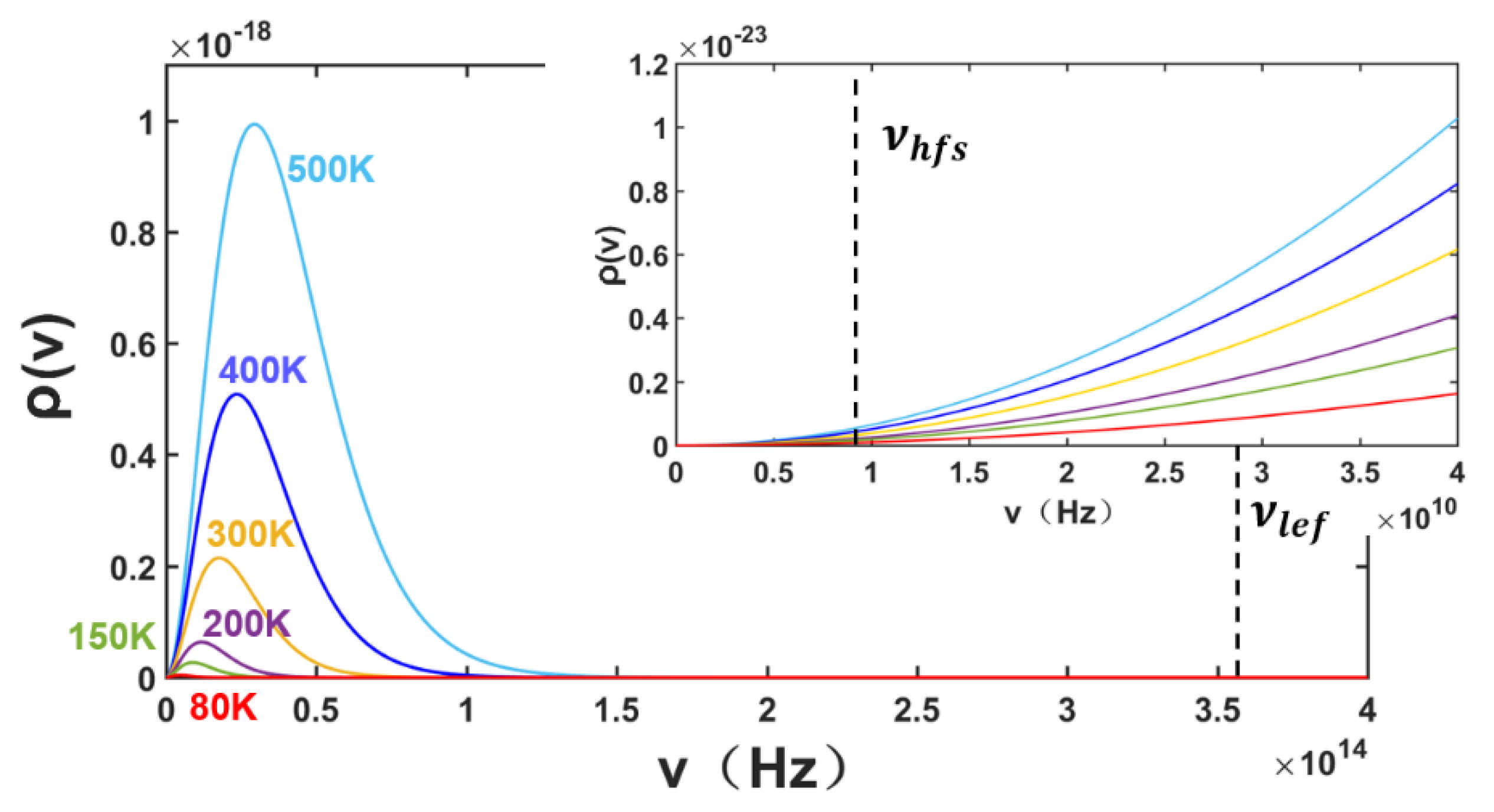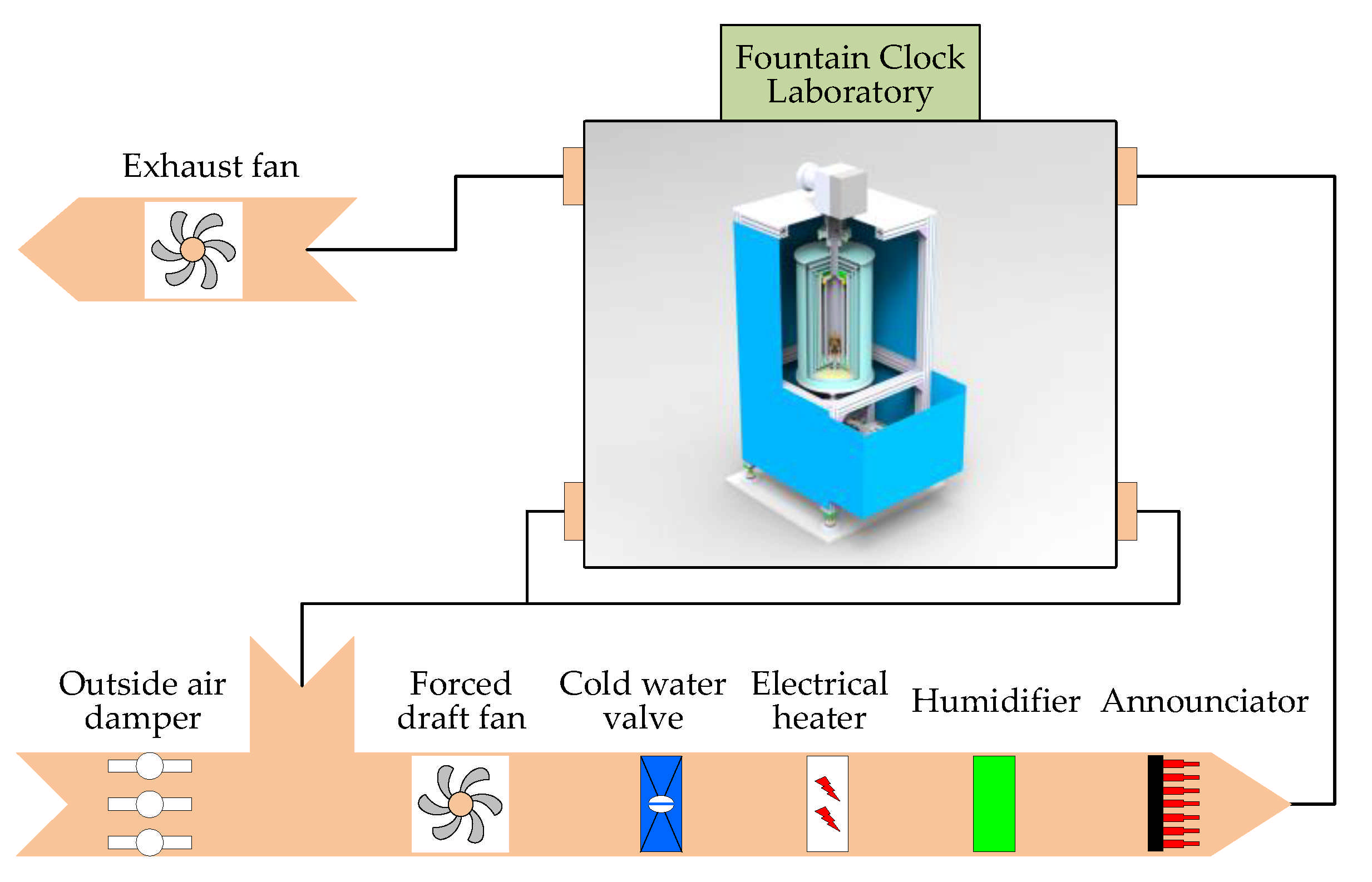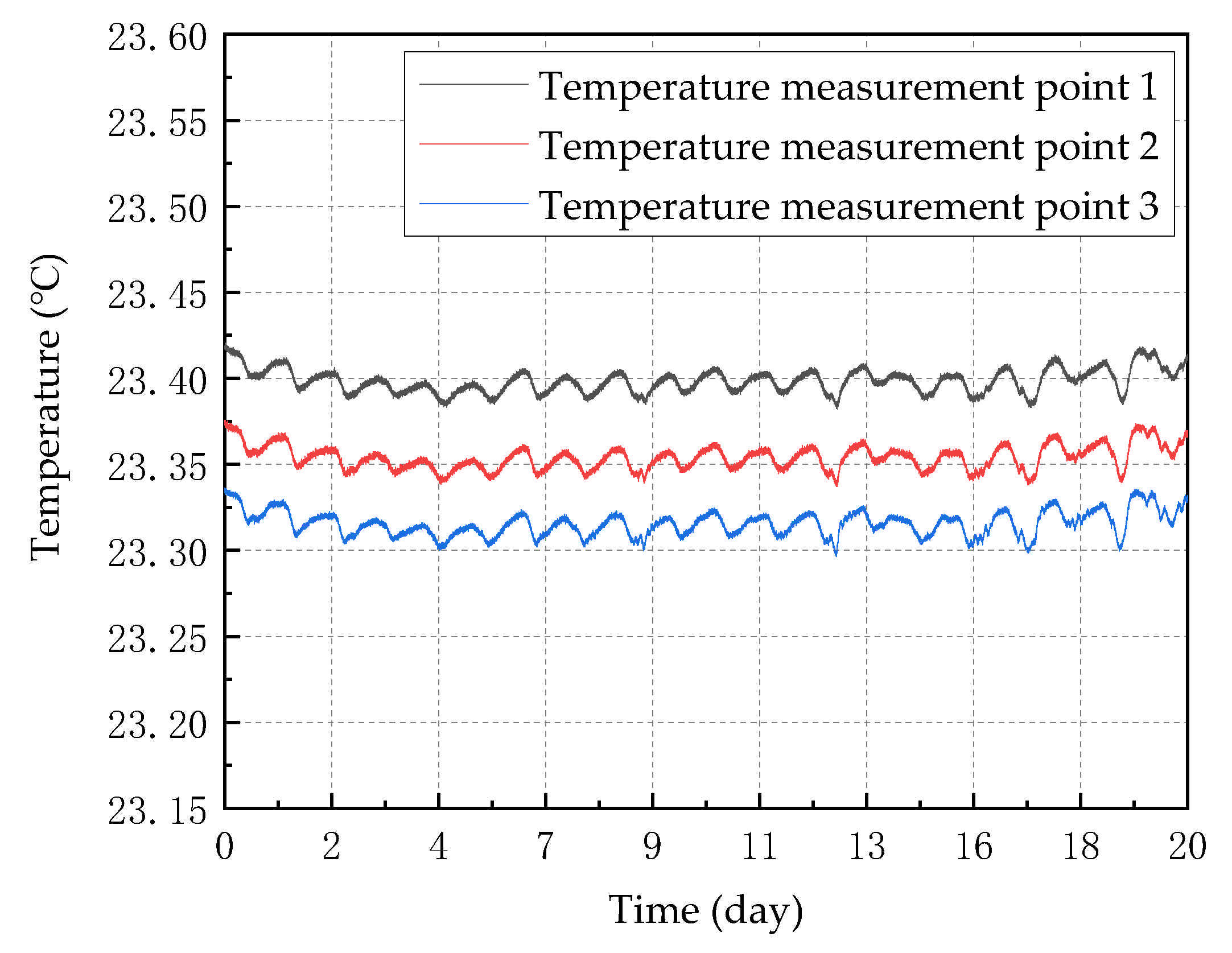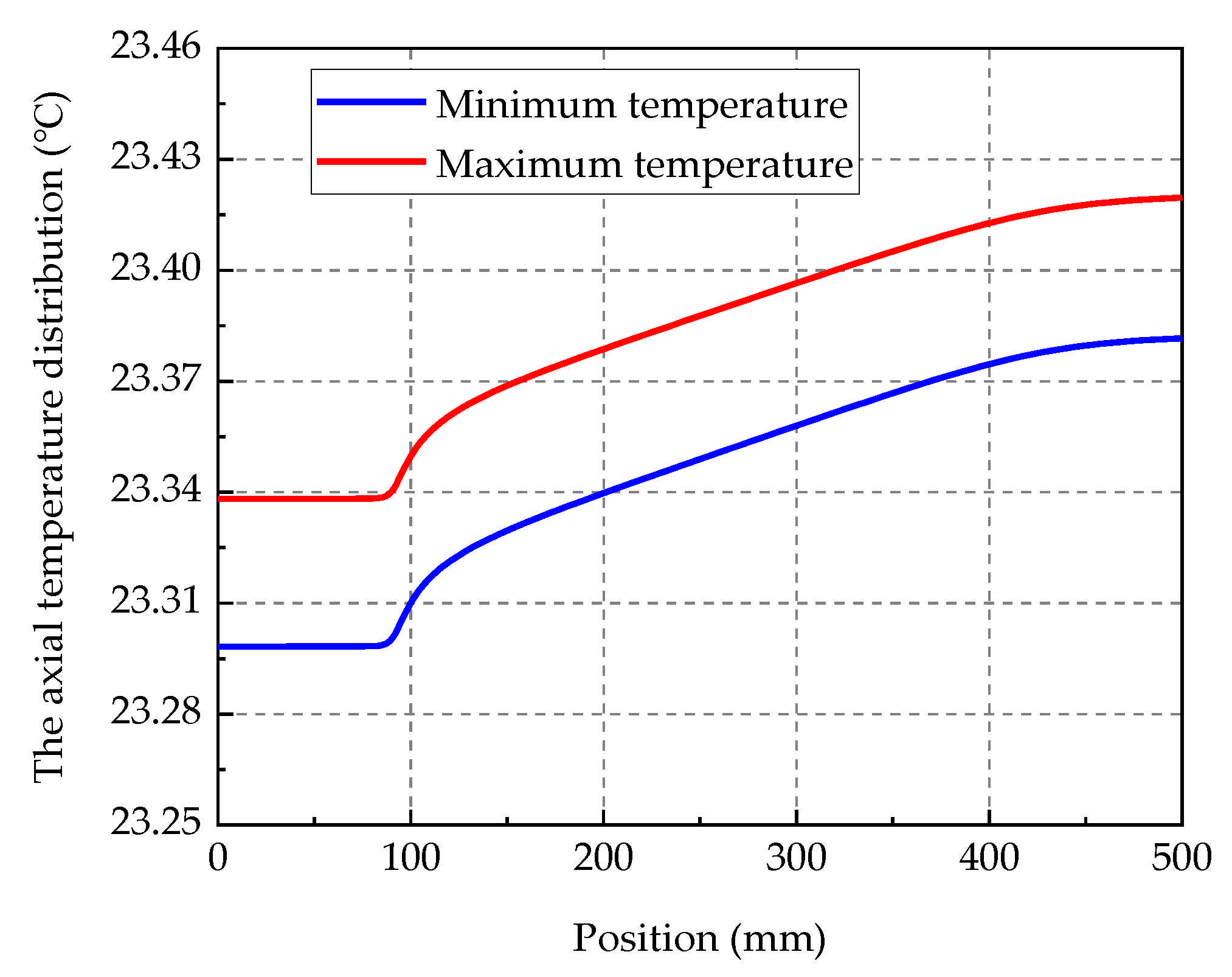1. Introduction
The cesium atomic fountain clock is the most advanced microwave frequency standard in the world and is used for many purposes, such as frequency measurement, international atomic time calibration [
1], high-precision spectroscopy [
2], testing basic physical theories [
3], and measuring basic physical constants [
4]. With the development of fountain clocks and the continuous improvement of uncertainty evaluation technology, it is very important to evaluate the frequency shifts and related uncertainties of cesium atomic fountain clocks. When the frequency uncertainty of a fountain clock reaches an order of magnitude of 10
−16, the influence of the blackbody radiation (BBR) shift on the uncertainty of the fountain clock becomes a key factor in the further improvement of the clock performance [
5,
6].
According to performance analyses of fountain clocks at research institutes in various countries, the uncertainty of BBR shift accounts for a large part of the total frequency uncertainty of fountain clocks. Laboratories have adopted a variety of design schemes to reduce the influence of the uncertainty of BBR shift on the performance of fountain clocks. There are two ways to reduce this uncertainty. One is to control the temperature fluctuations in the atomic flight zone. The Physikalisch-Technische Bundesanstalt (PTB) designed a copper vacuum pipeline for the atomic flight zone in its cesium fountain clock CSF2 to ensure the good temperature uniformity of the atomic flight path, and placed four PT100 temperature sensors along the vertical length of the outer wall of the copper pipeline to obtain accurate temperature measurements. The uncertainty of BBR shift determined for the cesium fountain clock was 6.3 × 10
−17 [
7,
8]. In the cesium fountain clock FCs2 designed by the National Research Institute of Canada (NRC), the vacuum pipeline of the atomic flight zone uses a double-walled aluminum structure to act as a water jacket. The water from the temperature-controlled water chilling unit is circulated through the water jacket to stabilize the temperature of the free flight zone and the microwave resonant cavity, and a copper flight tube is set above the resonant cavity to ensure a uniform temperature in the atomic flight area. Three T-type thermocouples are placed along the length of the water cooling jacket to monitor the temperature, and the resulting uncertainty of the BBR shift in the cesium fountain clock is 7.0 × 10
−17 [
9].
Another method is to lower the temperature of the atomic flight zone. In attempting to reduce the uncertainty of BBR shift, the US National Institute of Standards and Technology (NIST) and the Italian National Institute of Metrology (INRIM) have begun to develop cryogenic fountain clocks that create a continuous and stable cryogenic environment for the resonant cavity and fountain tube by cooling with liquid nitrogen, thereby reducing the ambient temperature and reducing the sensitivity coefficient of the BBR shift [
10,
11]. However, it is difficult to develop a cryogenic liquid nitrogen fountain clock, which needs high funding support [
10]. In a comprehensive comparison, the room-temperature fountain clock was found to have significant advantages.
In this study, we conduct a theoretical analysis of the mechanism of the BBR shift, and briefly describe the theoretical calculation of the uncertainty of BBR shift in the cesium fountain clock and our analysis of the methods used to reduce this uncertainty. With the cesium fountain clock in a room temperature environment as its focus, a fountain system structure with uniform temperature and good heat preservation was obtained through design of the physical structure, and related technologies, such as measurement of the temperature of the cesium fountain clock system, were studied. Over the course of 20 days of experimental measurements, the changes in the temperature distribution of the vacuum pipe in the atomic flight zone of the fountain clock with time were determined. To better explain the temperature distribution and changes in the atomic flight zone, computer simulations were conducted using the measurement results. The results showed that the temperature uncertainty of the atomic flight zone was less than 0.12 °C, and the resulting uncertainty of BBR shift was 2.4 × 10
−17, which corresponds to the international advanced level [
7,
8,
9,
12].
2. Theoretical Research on the Blackbody Radiation (BBR) Shift
BBR refers to the phenomenon by which objects at certain temperatures radiate electromagnetic waves. This radiation field has a broad frequency spectrum and can cause changes in the atomic energy levels. In the atomic free flight zone of the cesium fountain clock, cold atoms interact with an equilibrium thermal radiation field of approximately 300 K, and the movement of the hyperfine energy level causes a frequency shift of the cesium fountain clock [
13].
The thermal radiation emitted by a blackbody heated to a given temperature
T has a spectrum given by Planck’s law [
12,
14]:
where
h is Planck’s constant,
c is the speed of light, and
is the Boltzmann constant.
is the energy density of the BBR field, in J/Hz/m
3. BBR exhibits a very broad spectrum at room temperature [
15].
Figure 1 shows the relationship between the spectral density of a BBR field
and the frequency for several temperatures of the blackbody. The inset shown in
Figure 1 is a partial enlargement with frequency in the range of 0 to 4 × 10
10.
denotes the hyperfine splitting frequency in the ground state, and
denotes the lowest allowed electric dipole transition frequency.
The superfine energy level of cesium atoms interacts with the BBR field, and the energy level shift is affected by the adjacent energy level. The magnetic dipole transition in the microwave frequency band and line D2 of the electrical dipole transition in the optical frequency band have the greatest impact on the energy level shift.
The perturbation of the magnetic dipole transition on the ground-state energy level is mainly the second-order Zeeman effect of the BBR field on the transition
[
16]. Assuming there is a pure two-level quantum system subject to random perturbations, for a temperature of approximately 300 K the influence of the BBR field near the resonance part can be ignored because the contributions to the first-order transition by the two sides of the resonance point offset each other. The energy of the BBR field is mainly concentrated in the frequency
, where only the component of the random magnetic field in the direction of the C-field (the C-field is a static magnetic field produced by a long coil and used to provide aquantization axis) has an effect on the clock transition
. Therefore, one third of the isotropic magnetic field induction energy contributes to the AC Zeeman frequency shift:
where
is the amplitude of the magnetic induction component that oscillates at the frequency
ν, and
and
are the electron
g-factor and nuclear
g-factor, respectively. It can be observed that at room temperature, the frequency shift caused by the AC Zeeman effect owing to the BBR magnetic field is of the order of 10
−17, which is negligible compared to the other perturbations considered here.
It can be observed from
Figure 1 that the energy of the BBR spectrum is concentrated around 20 THz, which is much smaller than the electronic dipole transition frequencies of 335 THz for line D1 and 352 THz for line D2. This means that the BBR electric field can be approximated as a weak, slowly changing, non-resonant AC electric field [
17]. The influence of the BBR field can be approximated as a second-order Stark effect produced by the electrostatic field, which depends on the root mean square value of the electric field strength, and can be solved by perturbation theory. Since the induced electric dipole moment is directional, the tensor form of the polarizability must be used here. For the electric field acting on a single-electron atom, the energy change can be expressed as follows:
where
Ki,j is a 3 × 3 matrix. Taking the direction of the C-field as the z axis, owing to the rotational symmetry between the x and y directions,
Kx,x = Ky,y = K1 and
Kz,z = K2 can be set, and the Stark shift caused by the electric field can be expressed as follows:
where the first part is the scalar polarizability independent of the direction of the magnetic field, and the second part is the direction-dependent tensor polarizability. The tensor part is zero when we average over all directions. Using spherical tensor analysis, the frequency shift of the transition sub-level of a cesium fountain clock caused by the DC Stark effect in the BBR field is calculated, and the frequency shift of the clock transition can thus be obtained [
18]:
In this formula, the contributions of contact and spin dipole–dipole interaction correspond to the scalar polarizability
and the tensor polarizability
, respectively. The average contribution of the tensor polarization rate to the frequency shift is zero. The scalar polarizability
can be obtained by theoretical calculation and experimental measurement [
19]. The DC Stark frequency shift caused by the BBR field is determined from the root mean square of the electric field intensity. After substituting this into Equation (3), the theoretical value of the impact of the BBR shift on the clock transition at temperature
T can be obtained as follows:
A more accurate analysis of the BBR shift needs to consider the quantum characteristics of the BBR field. In 1981, Itano et al. proposed an approximate method [
20]. Taking into account the frequency spectrum distribution of the electronic dipole lines D1 and D2, the corrective term about
T6 was obtained, which accounts for the BBR spectrum with respect to the DC Stark shift of the Cs clock transition, and the expression for the total BBR shift is obtained as follows [
15]:
where
T0 = 300 K and
ε = 1.4 × 10
−2 [
19],
β can be obtained by theoretical calculation or experimental measurement; here, we take the direct measurement value in [
21],
β = (−1.43 ± 0.09) × 10
−14.
The uncertainty of BBR shift describes the sensitivity of the BBR shift to temperature fluctuations. The following expression of the uncertainty of BBR shift can be derived:
where Δ
T denotes the change of temperature. According to this formula, we can see that the uncertainty of BBR shift can be reduced by two methods. The first method is lowering the working environment temperature
T. Lowering the temperature can reduce the sensitivity coefficient of the uncertainty of BBR shift, thereby greatly reducing the uncertainty of BBR shift in a fountain clock. The cryogenic cesium fountain clock is based on this principle. The second method is reducing the uncertainty of the temperature, because the uncertainty of BBR shift is proportional to the uncertainty of the temperature. For every 0.1 °C decrease in the temperature uncertainty at
T = 300 K, the uncertainty of BBR shift decreases by 2.0 × 10
−17 approximately. For room-temperature fountain clocks, reducing the uncertainty of the system temperature is the most commonly used method to reduce the uncertainty of BBR shift.
4. Temperature Simulation and Analysis
After the temperature system had been improved, when the cesium fountain clock was operating normally and the system temperature had reached equilibrium, we monitored the temperature at the positions of the three Pt100 temperature sensors installed on the outer wall of the vacuum chamber for a long period of time, and obtained the curve of the change in temperature at each measurement point under normal operation (
Figure 5 shows the temperature values after deduction of the calibrated deviation).
The temperature measurement results shown in
Figure 5 represent the temperature distribution at the temperature measurement point on the outer wall of the vacuum pipe in the atomic flight zone, which theoretically cannot fully represent the atomic flight trajectory temperature of the fountain clock. In order to more accurately represent the spatial distribution of the temperature in the atomic flight zone and its variation over time, the finite element method was used to simulate the temperature distribution of the vacuum cavity and its interior, so as to obtain the temperature distribution of the resonant cavity and the atomic flight zone. We constructed a physical mechanical model, including the corresponding vacuum cavity, resonant cavity, resonant cavity bracket, and vacuum partial filler, and then defined the material properties of the model. The material of the vacuum cavity was TC4 titanium alloy (Ti-6Al-4V), and the material of the resonant cavity and its bracket were oxygen-free copper. The properties of the materials related to the temperature analysis, including the thermal conductivity, heat capacity, density, and other temperature-related parameters, were established. The vacuum part of the cavity was modelled as a substance, and its thermal conductivity, specific heat, density, and emissivity were set to approximate a vacuum environment.
According to the results of the long-term monitoring of the temperature measurement points on the outer wall of the vacuum chamber shown in
Figure 5, the temperature distribution of the vacuum chamber gradually increases from bottom to top, and the temperature change trends of the three temperature measurement points are completely consistent. Therefore, we performed only a thermal steady-state analysis of the two conditions of the lowest temperature and the highest temperature on the measurement curve to obtain the temperature distribution range of the resonant cavity and the atomic flight zone. We fixed the temperature for two cases. In the first case, the temperatures of the circumferential surface of the narrow-band vacuum chamber corresponding to temperature measurement points 1, 2, and 3 were set to the lowest temperatures of the temperature curve at the corresponding points, namely, 23.382 °C, 23.337 °C, and 23.296 °C, and a thermal steady-state simulation was performed. In the second case, the temperatures of the circumferential surface of the narrow-band vacuum chamber corresponding to the temperature measurement points 1, 2, and 3 were set to the highest temperatures of the temperature curve at the corresponding points, namely, 23.420 °C, 23.376 °C, and 23.336 °C, and a thermal steady-state simulation was performed. The temperature distribution curve of the central axis of the atomic flight zone in the two cases is shown in
Figure 6.
It can be seen from the measurement and simulation results that after the system reaches equilibrium, the spatial temperature fluctuation of the central axis of the atomic free flight zone is less than 0.1 °C, and the temporal temperature fluctuation is less than 0.05 °C. The temperature uncertainty caused by the sensors and the thermometer measurement is less than 0.02 °C, and the total temperature uncertainty caused by the three factors is less than 0.12 °C. The uncertainty of BBR shift, according to Formula (8), was 2.4 × 10−17.











